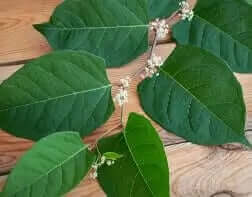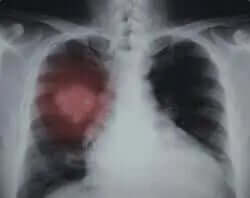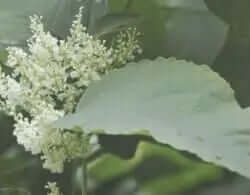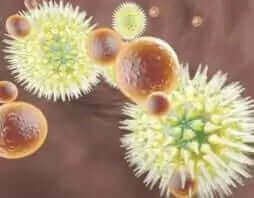Japanese Knotweed: Complete Guide to Identification, Control, and Hidden Benefits
Japanese Knotweed stands as one of nature's most resilient plants, offering surprising benefits while challenging gardeners worldwide. This comprehensive guide reveals everything you need to know about Japanese Knotweed, from identifying its distinctive features to understanding its remarkable properties and learning proven control methods that actually work.
Understanding Japanese Knotweed and Its Surprising Benefits
What makes Japanese Knotweed truly fascinating goes beyond its reputation as an invasive species. This robust perennial contains significant amounts of Resveratrol, the same beneficial compound found in grapes that supports heart health and longevity. While many view it solely as a garden menace, forward-thinking researchers recognize its potential as a sustainable source of valuable nutrients.
The plant's incredible resilience actually signals its strength as a medicinal powerhouse. Japanese Knotweed thrives where other plants struggle, developing potent compounds that protect it from environmental stress. These same compounds offer promising benefits for human health, making this "problem plant" a hidden treasure for those who understand its value.
How to Identify Japanese Knotweed: Essential Recognition Features
Proper identification of Japanese Knotweed empowers property owners to take swift action while appreciating this plant's unique characteristics. Known scientifically as Polygonum cuspidatum, this vigorous perennial appears in yards, abandoned sites, and waste areas where it establishes thriving colonies.
Key Identification Features of Japanese Knotweed
- Growth Pattern: Forms dense clumps with deep underground rhizomes spreading horizontally
- Height: Shoots grow rapidly each spring, reaching 3 to 9 feet tall
- Stems: Round, smooth, hollow between nodes, often displaying attractive reddish-purple mottling
- Structure: Can grow branched or unbranched with membranous sheaths at each node

Leaf Characteristics for Easy Japanese Knotweed Identification
The leaves of Japanese Knotweed display distinctive features that make identification straightforward once you know what to look for:
- Shape: Ovate leaves measuring 3 to 6 inches long and 2 to 5 inches wide
- Tips: Sharply pointed ends that taper elegantly
- Base: Square-cut or slightly angled where the leaf meets the stem
- Edges: Can appear smooth or slightly wavy depending on growing conditions
Flower and Seed Recognition
Late summer brings clouds of delicate flowers to Japanese Knotweed plants, creating an unexpectedly beautiful display:
- Color: Greenish-white flowers arranged in graceful panicles
- Location: Emerge from leaf-stem junctions in the upper plant portions
- Length: Flower clusters extend up to 6 inches
- Seeds: Brown, glossy, triangular seeds approximately 5/32 inch long
Common Misconceptions About Japanese Knotweed
Despite its widespread presence, many misconceptions surround Japanese Knotweed. Some sellers deceptively market it as "Mexican bamboo," creating confusion about its true nature. This plant originates from East Asia, not Mexico, and belongs to the buckwheat family rather than being related to bamboo.
Understanding its true botanical relationships helps appreciate why Japanese Knotweed shares beneficial properties with familiar plants like rhubarb. Both belong to the same plant family and produce similar beneficial compounds, though Japanese Knotweed contains them in much higher concentrations.
Effective Control Methods for Japanese Knotweed
Managing Japanese Knotweed requires patience and the right approach, but success brings the satisfaction of reclaiming your garden space. Multiple proven strategies exist for controlling this persistent plant while respecting its remarkable survival abilities.
Physical Control Techniques
Regular maintenance keeps Japanese Knotweed from overwhelming desired plantings:
- Root Excavation: Dig out rhizomes extending beyond the main clump 2-3 times yearly
- Persistent Cutting: Remove all shoots immediately upon emergence to gradually exhaust root reserves
- Nutrient Management: Avoid fertilizers and manure near affected areas to limit growth
- Barrier Installation: Deep root barriers can redirect growth away from sensitive areas

Chemical Control Options for Japanese Knotweed
When physical methods prove insufficient, targeted chemical applications offer effective Japanese Knotweed control:
Herbicide Resistance Considerations
Japanese Knotweed demonstrates remarkable resistance to many common herbicides, including 2,4-D formulations. This resistance actually highlights the plant's sophisticated defense mechanisms that contribute to its medicinal value.
Glyphosate Application Methods
Glyphosate products like Roundup provide reliable control when applied correctly:
- Foliar Spray: Apply during active growth for systemic action
- Stem Injection: Direct application minimizes environmental impact
- Wipe-On Method: Brush herbicide onto leaves for precise targeting
- Individual Treatment: Use spray bottles to protect surrounding vegetation
Safe replanting becomes possible after glyphosate breaks down completely, typically within weeks of application. This approach balances effective control with environmental responsibility.
Turning Challenge into Opportunity with Japanese Knotweed
Rather than viewing Japanese Knotweed purely as a problem, consider the opportunities it presents. Its vigorous growth means abundant raw material for those interested in natural health products. Some innovative gardeners harvest young shoots as a rhubarb substitute, while herbalists value the roots for their concentrated resveratrol content.
Sustainable Harvesting Practices
Responsible harvesting of Japanese Knotweed combines control with utilization:
- Spring Shoots: Harvest tender shoots under 8 inches for culinary use
- Root Collection: Dig roots in fall when resveratrol concentrations peak
- Processing Methods: Dry roots and stems for tea or tincture preparation
- Community Sharing: Connect with herbalists seeking sustainable sources
Long-Term Management Strategies for Japanese Knotweed
Success with Japanese Knotweed management comes from consistent application of integrated strategies. Combining physical removal, strategic chemical use, and ongoing monitoring creates sustainable solutions that transform this challenge into manageable routine.
Seasonal Management Calendar
| Season | Japanese Knotweed Management Tasks | Expected Results |
|---|---|---|
| Spring | Cut emerging shoots, harvest for consumption, apply herbicides | Reduced vigor, usable harvest |
| Summer | Continue cutting, monitor spread, dig peripheral rhizomes | Contained growth, weakened plants |
| Fall | Final herbicide application, harvest roots, prepare barriers | Systemic control, medicinal harvest |
| Winter | Plan next season, maintain barriers, process harvested materials | Strategic preparation, value creation |
Creating Positive Outcomes with Japanese Knotweed
Transform your relationship with Japanese Knotweed by recognizing its potential benefits while maintaining appropriate control. This remarkable plant teaches valuable lessons about resilience, adaptation, and finding opportunity within challenge. Property owners who master Japanese Knotweed management often discover newfound confidence in tackling other garden challenges.
The journey from viewing Japanese Knotweed as purely problematic to appreciating its complex nature represents growth in gardening wisdom. Each successful control effort builds skills applicable to broader landscape management, while harvesting efforts connect us to traditional plant knowledge and sustainable living practices.
Professional Resources and Support
For those seeking additional guidance with Japanese Knotweed, numerous resources provide expert support. University extension services offer identification guides and regional management recommendations. Local gardening groups share practical experience and moral support for those dealing with persistent infestations.
Professional landscapers increasingly recognize Japanese Knotweed management as a specialized skill worth developing. Their expertise combines traditional knowledge with modern techniques, creating comprehensive solutions tailored to specific situations.
Environmental Considerations and Japanese Knotweed
Understanding the ecological role of Japanese Knotweed adds depth to management decisions. While invasive in many regions, it provides erosion control on disturbed sites and supports certain pollinators during late-season blooming. Balanced management respects these ecological functions while preventing unwanted spread.
Climate change may alter Japanese Knotweed distribution patterns, making current management skills increasingly valuable. Properties with established control programs demonstrate resilience against future invasive species challenges, creating landscapes prepared for changing conditions.
Success Stories: Transforming Japanese Knotweed Challenges
Countless property owners have successfully transformed Japanese Knotweed infestations into manageable situations. Their stories inspire others facing similar challenges, proving that persistence and proper techniques yield positive results.
One memorable success involved a community garden that turned Japanese Knotweed removal into an annual harvest festival. Volunteers learned identification skills while collecting shoots for cooking demonstrations, transforming a maintenance task into educational celebration. Such creative approaches build community while addressing practical needs.
Frequently Asked Questions About Japanese Knotweed
What makes Japanese Knotweed so difficult to control?
Japanese Knotweed possesses extraordinary regenerative abilities through its extensive rhizome system that can extend 20 feet horizontally and 10 feet deep. Even tiny root fragments can sprout new plants, while its resistance to many herbicides stems from the same robust chemistry that makes it medicinally valuable. Success comes from understanding these strengths and applying persistent, multifaceted control strategies.
Can I eat Japanese Knotweed safely?
Yes, young Japanese Knotweed shoots under 8 inches tall are edible and taste similar to rhubarb with lemony notes. Harvest only from areas free of herbicide application and away from roadside contamination. The shoots contain beneficial compounds including resveratrol, making them both nutritious and medicinal. Many cultures have traditional recipes featuring this versatile plant.
How long does it take to eliminate Japanese Knotweed completely?
Complete elimination of established Japanese Knotweed typically requires 3-5 years of consistent management, though visible improvement occurs much sooner. The timeline depends on infestation size, chosen control methods, and management consistency. Many gardeners find that after the first year, maintenance becomes routine rather than overwhelming, with each season bringing noticeable progress.
What are the medicinal benefits of Japanese Knotweed?
Japanese Knotweed contains high concentrations of resveratrol, a powerful antioxidant linked to cardiovascular health, anti-aging benefits, and potential cancer prevention. The plant also provides anti-inflammatory compounds and supports immune function. Traditional medicine systems have used it for centuries, and modern research continues revealing new therapeutic applications.
Should I hire professionals for Japanese Knotweed removal?
Professional help makes sense for large infestations, time-constrained property owners, or situations requiring guaranteed results. Specialists bring experience, proper equipment, and access to professional-grade treatments. However, motivated homeowners can achieve excellent results with patience and proper techniques. Consider starting DIY efforts and consulting professionals if progress stalls.
Can Japanese Knotweed damage building foundations?
While Japanese Knotweed rarely damages sound foundations directly, it exploits existing cracks and weaknesses, potentially worsening structural issues. Its powerful growth can lift paving, penetrate drainage systems, and compromise retaining walls. Regular monitoring and prompt control near structures prevents costly damage while maintaining property values.
What's the best season to start Japanese Knotweed control?
Spring offers ideal conditions for beginning Japanese Knotweed control when new shoots emerge and plants actively grow. This timing maximizes herbicide effectiveness and allows full growing season for repeated treatments. However, successful management can begin any time during active growth, with fall applications particularly effective for systemic herbicides as plants transport nutrients to roots.
How do I dispose of Japanese Knotweed waste safely?
Japanese Knotweed requires careful disposal to prevent spread. Never compost fresh material or dump it where it might establish. Options include thorough drying until completely dead, burning where permitted, or professional disposal services. Some areas classify it as controlled waste requiring special handling. Always check local regulations for proper disposal methods.
Can I use Japanese Knotweed as mulch after treatment?
Only use Japanese Knotweed as mulch after ensuring complete death through extended drying or composting at high temperatures. Living fragments will sprout if used fresh. Properly processed material creates nutrient-rich mulch, turning a waste product into garden resource. This approach exemplifies sustainable management that finds value within challenge.
What wildlife benefits from Japanese Knotweed?
Despite its invasive nature, Japanese Knotweed supports various wildlife. Bees and other pollinators visit late-season flowers when few alternatives exist. Dense stands provide cover for small mammals and nesting sites for some birds. Understanding these ecological connections helps develop management strategies that balance control needs with wildlife support.
Conclusion: Embracing the Japanese Knotweed Journey
Managing Japanese Knotweed transforms from daunting challenge to achievable goal when approached with knowledge, patience, and positive perspective. This remarkable plant teaches valuable lessons about persistence, adaptation, and finding opportunity within adversity. Whether you choose aggressive elimination or sustainable management with harvesting, success comes from consistent application of proven techniques.
Your journey with Japanese Knotweed connects you to a global community of gardeners facing similar challenges. Share your experiences, learn from others, and celebrate each small victory along the way. Remember that every expert was once a beginner who refused to give up. With the comprehensive strategies outlined in this guide, you possess the tools needed to transform your Japanese Knotweed situation from problem to opportunity.
The path forward shines bright with possibility. Each day brings new chances to apply these techniques, build your skills, and create the landscape you envision. Your success story awaits, ready to inspire others on their own Japanese Knotweed management journey.
References:







